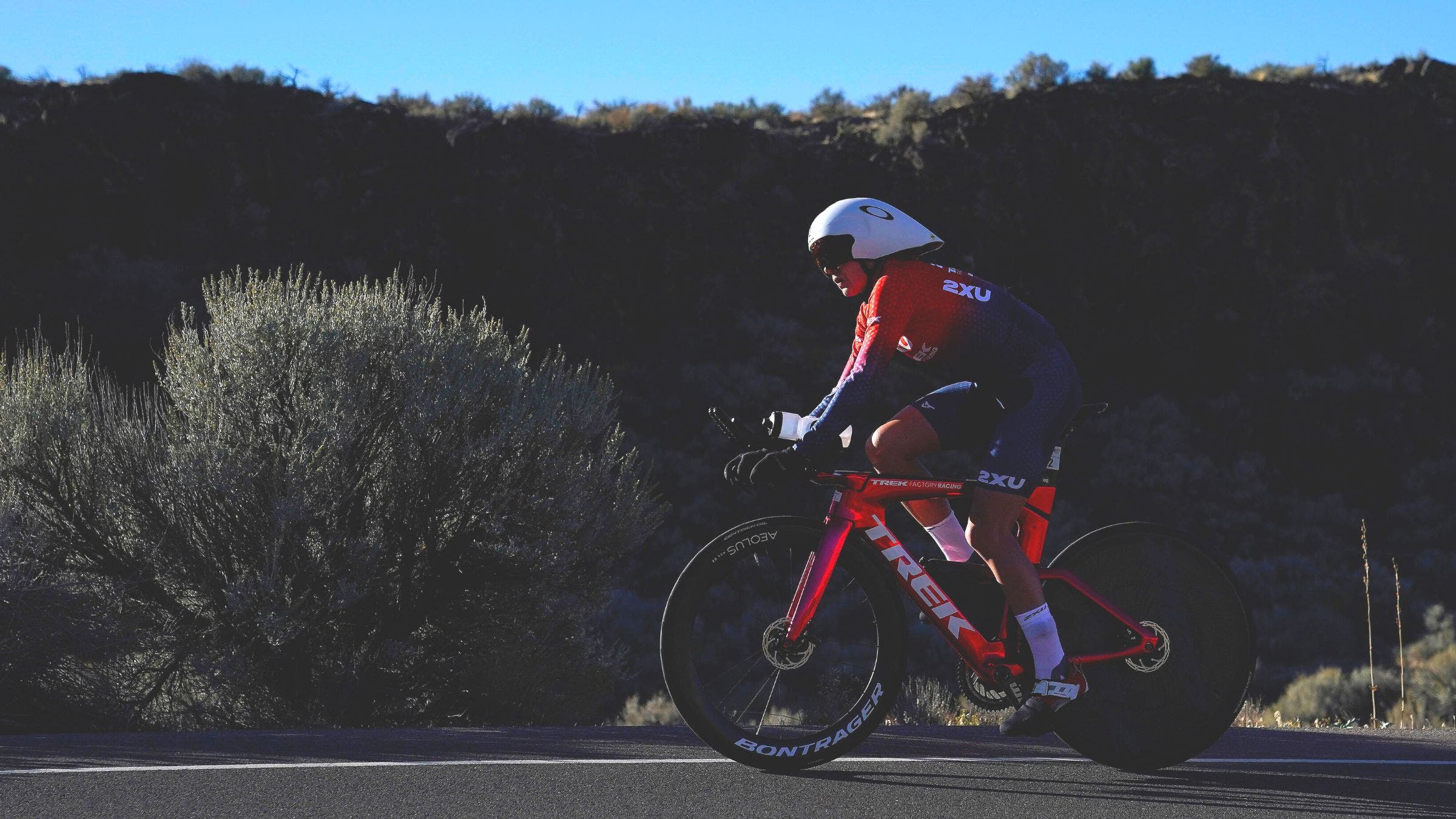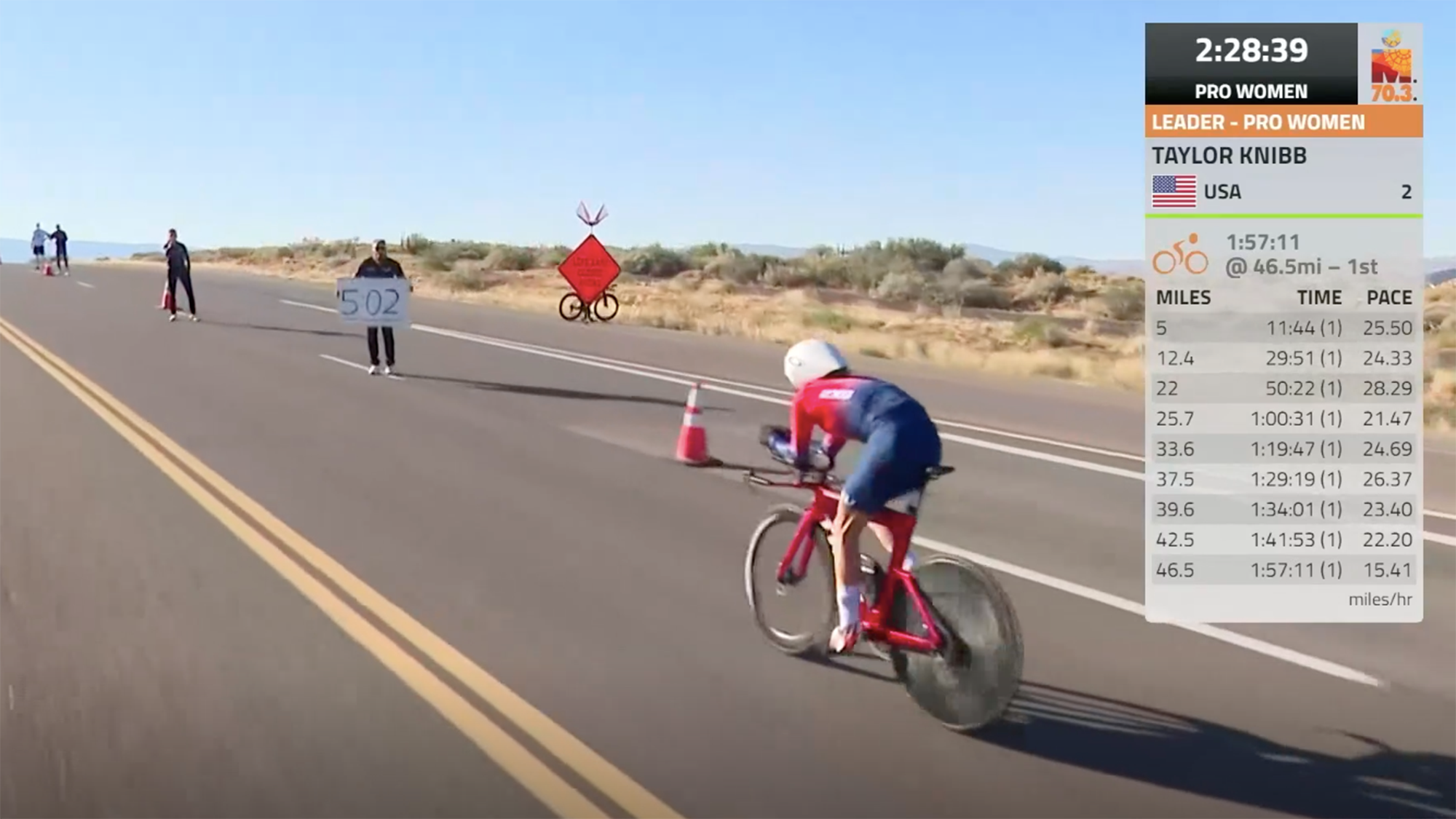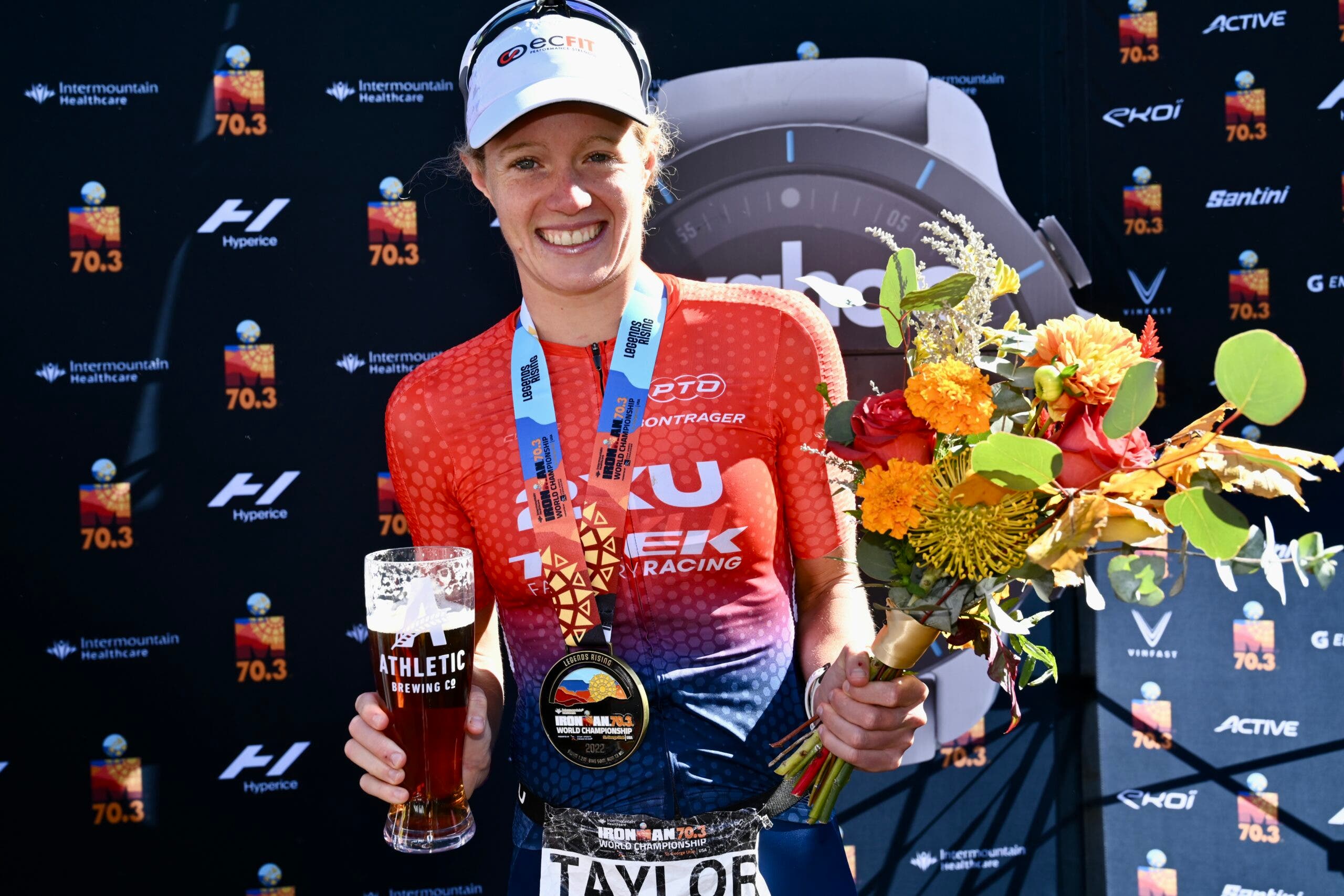The Training Secrets Behind Taylor Knibb's 70.3 Worlds Win

(Photo: Patrick McDermott/Ironman)
Want to win an Ironman 70.3 world title Taylor Knibb-style? Then follow these two simple rules.
Rule #1: Do the right thing, all the time, every time.
Rule #2: Be accountable. Own what you’re doing because If you don’t take responsibility, you can’t make changes.
Ok, there’s probably a little bit more to it than that, but the words of wisdom from Knibb’s coach, Ian O’Brien (who also currently holds the title of USAT Olympic Triathlon Coach of the Year), seem to hold true as anyone watching Friday’s race in St George will attest. O’Brien is the US-based former British Army soldier whose assured hand has been guiding the majority of the phenom’s development in Colorado since 2015.
O’Brien would also maybe also add Rule #3: Have some fun. Knibb’s bike training on the comeback trail from injury included a tour of Boulder, chasing down as many Queen of the Mountain (QOM) segments on Strava as possible. Those QOMs came as part of 20-hour weeks in the saddle as Knibb built back from a foot injury and helped lay the foundations for a 2:14:40 bike split in St George that was a clear six minutes faster than the field.
The irony is that O’Brien’s athletes from his much-admired Origin Performance Group don’t even use Strava. (Well, not very often.)
“We needed to give Taylor something to get her teeth into because she wasn’t racing,” O’Brien explains. “When you live in Boulder and all the QOMs are owned by professional cyclists, it’s a good gauge to figure out where we’re at. Most were taken by pros who had a lead out train of men, Taylor Knibb had just Taylor Knibb, broke all the records and was smiling up every hill while doing it.”
RELATED: The Unusual Story (and Unusual Coach) Behind Taylor Knibb’s Overnight Success

Work hard, stay humble
It was more strategic than it sounds. O’Brien first researched elevations and gradients of Strava segments to make sure they were targeted to the race in Utah, and there was also a discussion about whether to post the results on her public profile.
“She’s not a showboater at all,” O’Brien says. “She’s never ‘look at me’. You even have to give her a kick to post something on social media. For Taylor, it’s just about the achievements.”
And what achievements they’ve been. This weekend the 24-year-old became the youngest woman to win the Ironman 70.3 world title and the first American woman since 2008. Knibb already has junior and Under-23 short course world titles to her name and an Olympic silver medal from the mixed team relay in Tokyo. She won last year’s World Triathlon grand finale, has beaten Daniela Ryf on a road bike in the Collins Cup and is currently PTO-ranked world No 4. The list just keeps getting longer, and the scary prospect for her rivals is that the most feared cyclist in the sport right now just keeps getting better.
“We knew her bike was strong, but I know that it’s still not at the top of where it can be,” O’Brien says ominously.
“The biggest challenge for me with Taylor – and I find this with every athlete I’ve worked with who has won a world championship or Olympic medal – is holding them back. She’s clever at hitting her normalized power in training, but she’ll add a bit in to get the feeling of going hard, and then have to dial it back. I call it the Knibb Ramp, and I catch her every time. I screenshot the workout and text it to her: What is this? She just sends back laughing emojis.”
Even the injury that kept Knibb out of action since May was seized upon as an “opportunity” that allowed for a greater focus on swimming. The switch from a short course yards pool to extended sessions in a long course meters pool reduced the push-offs from the wall and also put Knibb in a position to swim close to the front of the race in Sand Hollow Reservoir. It worked – she exited the water in third.
By then, both coach and athlete had already figured it might be a special day.
Managing the conditions of (a very cold) 70.3 Worlds
“I got to the swim start an hour before she did on race morning and set up a spare bike on rollers, so it was ready. As Taylor was warming up she called me over to show me she was actually doing the exact power that I’d prescribed – it’d only taken two years! But she was laughing and joking and although neither of us would say, we felt it was going to be a great day.”
Keeping the mood light shouldn’t be perceived as having a slapdash approach. “Taylor does a very good job of being this bubbly person, but in the background she can be very serious, and it’s ‘game on’.” That focus stretched to one of the most discussed aspects of the 70.3 Worlds, how to handle the morning chill for athletes emerging from a lake of 65 degrees to air temperature of 40.
“We knew it was going to be cold,” O’Brien adds. “I drove the course at that time of day the morning before. Yes, the sun was up, but because of the mountainous terrain a large percentage of the bike ride remained in shadow. To that end, we decided to sacrifice time in T1. As soon as Taylor came out of the water she was to completely towel down, put on socks, gloves and a jacket and it would pay dividends within minutes.”
Knibb subbed in a large towel to absorb as much water from her suit as possible and pulled on a thermal cycling jacket with the pockets sewn up to limit the drag. They even tested it the day before to make sure it was aerodynamic enough, but the key was to be comfortable first. “We needed to eliminate the windchill factor so her body wouldn’t shut down.”
As Knibb powered to the front within 5 miles the only thing being shut down were the chances of her opposition, among them reigning champion Lucy Charles-Barclay. The Brit had solo’d off the front last year to win the race as Knibb – on a road bike and still a novice at non-drafting racing – eventually finished third. It was a very different scenario in 2022. “We’ve worked heavily with Trek and Ivan O’Gorman on bike fitting – who all my athletes use – to slowly drop her position down,” O’Brien explains. “We wanted to break people in the first hour on the bike.”
As with Oceanside 70.3 in April, where Knibb again dominated with the fastest bike split, the plan was to put the power down early. Yet this time it continued. Every time O’Brien held up his whiteboard showing the splits the gap had grown, the final climb up Snow Canyon adding another full minute to the deficit.

In the end, it became an impressively even effort, and the coach believes retaining a higher cadence also helped in the early miles of the half-marathon. “There’s some evidence to say a slower cadence is more effective,” O‘Brien adds. “But if your cadence is 70rpm and you’re trying to run at 180 steps per minute it’s difficult, and she did a really good job of sustaining 90rpm throughout the bike leg.”
It then became all about control and repeating what had been done in training. Another coaching mantra of the training group is that repetition creates belief, belief creates confidence, confidence enables control and control develops capabilities.
“I don’t give her any pointers, no form cues, nothing,” O’Brien says. “The only thing I give Taylor is splits so she can react if necessary. She stays in control and does the systems check: Am I running at the right pace? Am I fueling? Am I taking the right lines? How’s my cadence? Am I doing the right thing, all the time, every time?”
The O’Brien ecosystem
While O’Brien coaches up to 21 sessions of swim, bike and run a week to around 16 professionals (mainly Olympic-focused) he doesn’t work in isolation. The set-up at Origin draws in experts in strength training, sports massage and medicine, physiotherapy and nutrition. He even works with sports scientists and mentors to develop his own performance as head coach.
“The group ecosystem is coach-driven but we work by the athlete and coach making key strategic decisions and everyone else supporting. We try and connect with the best people in every area to get the best out of what we do and my job is to oversee everything. We have a flowchart of how it works to make sure nobody gets in the wrong lane.”
While O’Brien runs an independent ship, he was contracted as the US Olympic coach for Tokyo and and has worked with national federations all over the world from Brazil to South Africa, Korea to Spain.
“It never ends, consistently evolves, which is why I love it. Athletes can be happy or sad, but I remain stoic the whole time. I get a really good sense of where they’re at that way.”
Where Knibb is at right now is targeting the Olympic Games, with the number-one priority being health, and then performance. From here on it will be about seizing opportunities to increase her level so she can qualify for Paris 2024 and then have her best day in the French capital – knowing that her bike strength now makes her a marked woman in draft-legal racing.
Whether that will mean any more 70.3 racing remains to be seen, but whatever decisions they make rest assured they’ll be doing all they can to do the right thing, all the time, every time.

Taylor Knibb’s Pre 70.3 Worlds Key sessions:
Swim:
6 days out – Last hard swim before the race
1500m speed = Olympic Distance race velocity
Drills: All drills are specific to Taylor’s needs and areas of growth
Short Course Yards at 5,318ft Elevation
Warm-up:
Light band work 4 mins
300 Easy with every 4th 25 backstroke
200 as 50 kick 50 easy free
3 x 100 as 50 Drill/scull 50 easy free
200 as descend by 50 as 1-3, 4 easy
(1000/1000)
Activate:
2 x 200 Pull (with focus on push phase) on 2’40
2 x 100 as (25 Fly 75 free focus on form) on 1’30
4 x 50 as (25 at 1500 speed 25 easy) on ’50
(800/1800)
Set:
2 Rounds:
400 Pull strong with 2 x sights every odd 25 on 5’00 (focus is maintain momentum despite sighting)
3 x 200 at 1500 speed on 2’30
4 x 50 with bands (hip drive focus) on ’50
100 Easy Flush on 2’00
no rest between rounds
(2600/3400)
Cooldown:
300 as 75 free easy 25 backstroke
200 easy choice
Total: 3900 yards
RELATED: How to Choose the Best Swim Drills For You
Bike:
10 days out – Last long ride before the race
Warm up and cool down is governed by HR. Intervals are governed by power.
We do not use zones for prescribing cycling training. We use time at specific power that stimulates specific physiological adaptations based on lab and field testing. So for ease of use we have used WKO iLevels (below):
- 7 PMAX
- 7a PMAX/FRC
- 6 FRC
- 5 FRC/FTP
- 4 Threshold (FTP)
- 4a Sweet Spot
- 3 Tempo
- 2 Endurance
- 1 Recovery
Warm-up: (Aim is to gradually prepare the body for the Main Sets)
30 mins gradual warm up (Z1-Z2)
10 mins (High Z2)
5 mins (Low Z2)
8 x :90 at Low Z3 with :90 Recovery
5 mins (Low Z2)
Set 1:
3 rounds of
45 mins High Z3/ Low Z4a
6 mins Z2
Set 2:
3 rounds of
8 mins High 4a
4mins Flush (Z1-Z2)
Cooldown (aim is return back to pre-exercise state):
30 mins Gradual flush Z2-Z1
Dynamic stretch
RELATED: Dynamic Vs. Static Stretching
Progression + Hills Run:
A week out from the race – Race sharpener
Warm-up:
15 mins easy
Drill sets (Specific for Taylor)
6 mins Cruise
Set:
10 mins at 3:40min/km
4 mins easy
9 mins 3:30min/km
3 mins float
6 mins at 3:20min/km
2 mins float
3 mins at 3:10min/km
5 mins easy
4 x 300m Hill Reps – Smooth and not fast. Strength and alignment focus. Turn over kept high despite gradient and stride length shortened but controlled. With easy jog recoveries
Cooldown:
10-15 mins easy recovery
Dynamic stretch